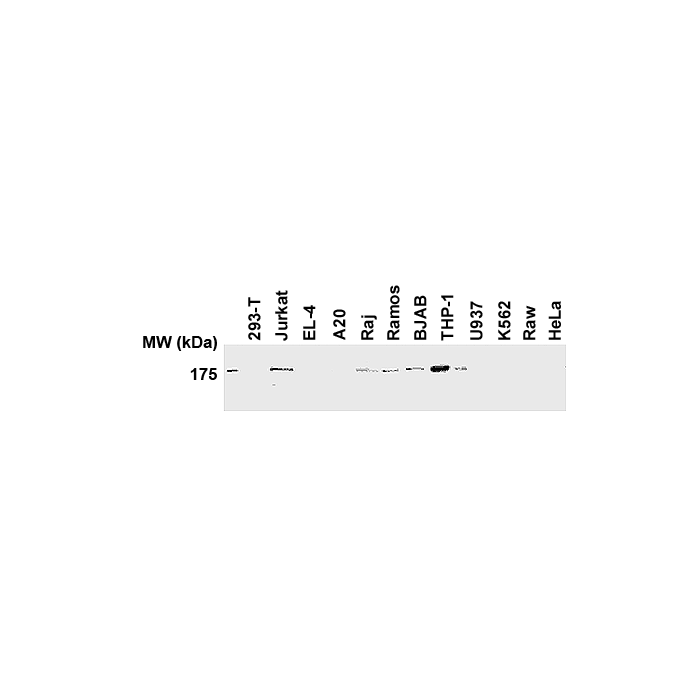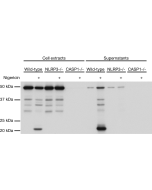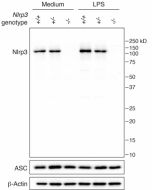Cookie Policy: This site uses cookies to improve your experience. You can find out more about our use of cookies in our Privacy Policy. By continuing to browse this site you agree to our use of cookies.
AdipoGen Life Sciences
anti-NLRP1/NALP1 (human), pAb (AL176)

Method: Total protein extracts (20μg) from various human (293-T, Jurkat, Raj, Ramos, BJAB, THP-1, U937, K562, Raw, HeLa) and mouse (EL-4, A20) cell lines were run on SDS-PAGE and NLRP1/NALP1 detected using anti-human NLRP1/NALP1 antibody (AL176) at 1:500 dilution. Anti-rabbit IgG coupled horse radish peroxidase was used at 1:5000 dilution for ECL detection.
| Product Details | |
|---|---|
| Synonyms | NACHT-, LRR- and PYD-containing Protein 1; NLRP1; Caspase Recruitment Domain-containing Protein 7; Death Effector Filament-forming Ced-4-like Apoptosis Protein; Nucleotide-binding Domain and Caspase Recruitment Domain |
| Product Type | Polyclonal Antibody |
| Properties | |
| Source/Host | Rabbit |
| Immunogen/Antigen | Synthetic peptide corresponding to aa 2-25 (A2GGAWGRLACYLEFLKKEELKEFQ25) at the N-terminus of human NLRP1/NALP1. |
| Application |
Western Blot: (1:1’000) IHC |
| Crossreactivity | Human |
| Specificity |
Recognizes human NLRP1/NALP1. Does not cross-react with mouse NLRP1/NALP1. |
| Concentration | 1 mg/ml |
| Formulation | Liquid. In PBS containing 10% glycerol and 0.02% sodium azide. |
| Isotype Negative Control | |
| Shipping and Handling | |
| Shipping | BLUE ICE |
| Short Term Storage | +4°C |
| Long Term Storage | -20°C |
| Handling Advice |
After opening, prepare aliquots and store at -20°C. Avoid freeze/thaw cycles. |
| Use/Stability | Stable for at least 1 year after receipt when stored at -20°C. |
| Documents | |
| MSDS |
 Download PDF Download PDF |
| Product Specification Sheet | |
| Datasheet |
 Download PDF Download PDF |
NALP1/NLRP1 is able to form cytoplasmic structures termed death effector filaments. It enhances and stimulates apoptosis through activation of different caspase cascades. It is involved in the activation of caspase-1 and caspase-5 as part of the NALP1 inflammasome complex which leads to processing and release of IL1B and IL18.
Genetic variations in the NLRP1/NALP1 gene are associated with susceptibility to vitiligo-associated multiple autoimmune disease type 1, an autoimmune disorder characterized by the association of vitiligo with several autoimmune and autoinflammatory diseases including autoimmune thyroid disease, rheumatoid arthritis and systemic lupus erythematosus.
- The inflammasome: a molecular platform triggering activation of inflammatory caspases and processing of proIL-beta: F. Martinon, et al.; Mol. Cell. 10, 417 (2002)
- Germline NLRP1 Mutations Cause Skin Inflammatory and Cancer Susceptibility Syndromes via Inflammasome Activation: F.L. Zhong, et al.; Cell 167, 187 (2016)
- The NLRP1 Inflammasome Pathway Is Silenced in Cutaneous Squamous Cell Carcinoma: J. Sand, et al.; J. Investig. Dermatol. 139, 1788 (2019)
- NLRP1 variant M1184V decreases inflammasome activation in the context of DPP9 inhibition and asthma severity: J. Moecking, et al.; J. Allergy Clin. Immunol. 147, 2134 (2021)
- Critical roles of irradiance in the regulation of UVB-induced inflammasome activation and skin inflammation in human skin keratinocytes: TA. Lee, et al.; J. Photochem. Photobiol. 226, 112373 (2022)
- Spleen tyrosine kinase regulates keratinocyte inflammasome activation and skin inflammation induced by UVB irradiation: PH. Lu, et al.; Free Radic. Biol. Med. S0891 (2022)
- Inflammasome sensor NLRP1 disease variant M1184V promotes autoproteolysis and DPP9 complex formation by stabilizing the FIIND domain: J. Moecking, et al.; J. Biol. Chem. 298, 102645 (2022)







